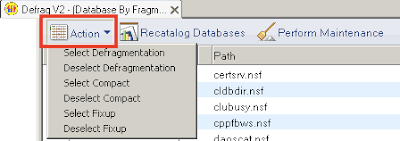Here's Part 2 of the Guided Tour series, looking at the Maintenance buttons.
Each view has the following buttons available to perform defrag maintenance related tasks, they include an Action, Recatalog Databases and Perform Maintenance buttons.
The Action button:

After manually selecting one or more databases, clicking the “Action” button allows the administrator to select or de-select the listed maintenance tasks.
Selected tasks will be indicated with a Green tick in the appropriate column for the databases to be processed during the next maintenance run.
The Recatalog Databases button:
The Recatalog button tells Defrag.NSF to catalog the databases on the server and create a document for each one. During this process it will also check the fragment count, database size and the Selection Method, so that any databases matching the selection criteria you have configured on the Technical Settings document can be flagged for follow-up maintenance. This will be seen as a Green tick in the appropriate column for the type of maintenance selected.

The Perform Maintenance button:
Clicking the “Perform Maintenance” button tells Defrag.NSF to recatalog the databases as described previously and then proceed with carrying out any of the maintenance tasks that have been flagged as a result of the Selection Method applied during recataloging process.
After clicking the “Perform Maintenance” button the user is presented with a dialog box with the option to proceed with the maintenance in the default manner, which includes a recatalogging of the databases, or alternatively, the user can elect to perform the maintenance without recatalogging, in which case Defrag.NSF will go straight into defragging and only the already selected databases (displaying the Green tick) will be processed. This is very useful if you have several thousand databases on the server and want to manually defrag only 1 or 2 specific databases while avoiding a complete recatalogging of all the databases on the server.
A defragging operation will always follow the other selected maintenance tasks. For example, a database that is flagged for compacting will be compacted first and then defragged to complete the maintenance.
Next in this series we will be looking at the many options available to the administrator when configuring individual database maintenance, these can include compacts, fixups and freespace monitoring/injection.


No comments:
Post a Comment